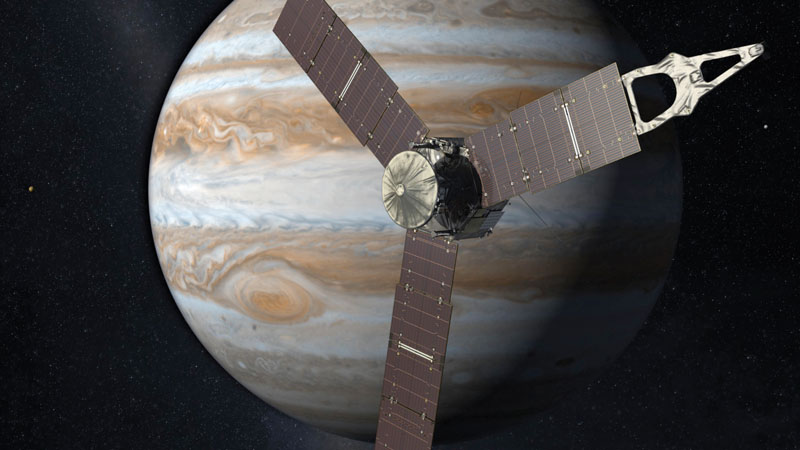Stay Up to Date
Submit your email address to receive the latest industry and Aerospace America news.
The Aerospace Power Systems Technical Committee focuses on the analysis, design, test or application of electric power systems or elements of electric power systems for aerospace use.
The Juno spacecraft arrived in orbit around Jupiter on July 4 after a five-year journey. The mission is part of NASA’s New Frontiers Program and is managed by NASA’s Jet Propulsion Laboratory for the principal investigator, Scott Bolton, of Southwest Research Institute in San Antonio.
In January, Juno became the most distant solar-powered spacecraft and has now completed the first of 36 orbital flybys of Jupiter, sending back the first images ever of Jupiter’s North Pole and the first infrared images of its South Pole.
The solar arrays are performing as predicted in this low-intensity sunlight, low-temperature environment. As opposed to the Galileo mission, whose power system was not affected by the radiation belts, Juno adjusted its orbit to reduce the radiation impact on the solar arrays by following a polar elliptical orbit outside of the radiation belts and going in for short-duration flybys. The solar array performance is closely monitored to help inform future deep-space solar missions.
NASA’s Radioisotope Power Systems program, led by JPL, is transferring to industry partners new thermoelectric energy conversion technologies that use skutterudite thermocouples. The target application would be a one-for-one substitution of the couples in the flight-proven Multi-Mission Radioisotope Thermoelectric Generator, with the potential to enhance its power output by 50 percent at the end of a 14-year mission application. The program also has initiated a procurement for prototype candidate converters demonstrating efficient dynamic power conversion. In addition to investments in energy conversion technologies, the program, in partnership with the U.S. Department of Energy, restarted production of the heat-source material.
Production capabilities of plutonium dioxide continued to be scaled upward this year toward a goal of 1.5 kilograms per year, after the Plutonium-238 Supply Project, led by the Energy Department’s Oak Ridge National Laboratory in Tennessee, achieved a long-awaited milestone by producing a 50-gram sample of Pu-238. It was the first new Radioisotope Power System fuel produced in the United States in nearly 30 years.
Preliminary testing of the Kilopower nuclear technology demonstration assembly using an electrically heated stainless steel reactor core simulator was conducted at NASA’s Glenn Research Center near Cleveland. This demonstration of a small fission reactor power system is focused on space missions needing 1-10 kilowatts-electric. The reactor has a 4-kW thermal uranium-molybdenum reactor core, sodium heat pipes for heat transfer and Stirling power converters created during the Advanced Stirling Radioisotope Generator program. A full nuclear demonstration is planned for late 2017 at the Nevada Nuclear Security Site. The demonstration is a partnership between NASA and the Energy Department’s National Nuclear Security Administration.
Also this year, an Orion solar array wing was deployed inside the Space Power Facility at NASA Glenn’s Plum Brook Station. The deployment of the 7.3-meter wing qualification model was an important first step to verify Orion’s power system before Exploration Mission-1 in 2018. A NASA Space Launch System rocket will boost an unmanned demonstration version of Orion tens of thousands of kilometers beyond the moon. The solar array is based on the European Space Agency Automated Transfer Vehicle’s X-shaped array of four panels. Together, the four panels will generate 11 kilowatts of power and span about 19 meters when extended. The array is a component of Orion’s service module, which the European Space Agency is providing and Airbus Defense and Space is building to supply Orion’s power, propulsion, air and water. ★
Stay Up to Date
Submit your email address to receive the latest industry and Aerospace America news.




